Remote Sensing and Spatial Analysis for Land-Take Assessment in Basilicata Region (Southern Italy)
Abstract
:1. Introduction
2. Materials and Methods
2.1. Study Area
2.2. Data Set and Preprocessing
2.3. Support Vector Machine (SVM) and Classification Methodology
3. Results
3.1. Land-Use/Land-Cover (LULC) Classification
3.2. Land Take Classification
4. Discussions
5. Conclusions
Author Contributions
Funding
Acknowledgments
Conflicts of Interest
References
- Marquard, E.; Bartke, S.; Font, J.G.I.; Humer, A.; Jonkman, A.; Jürgenson, E.; Marot, N.; Poelmans, L.; Repe, B.; Rybski, R.; et al. Land Consumption and Land Take: Enhancing Conceptual Clarity for Evaluating Spatial Governance in the EU Context. Sustainability 2020, 12, 8269. [Google Scholar] [CrossRef]
- Seto, K.C.; Güneralp, B.; Hutyra, L.R. Global forecasts of urban expansion to 2030 and direct impacts on biodiversity and carbon pools. Proc. Natl. Acad. Sci. USA 2012, 109, 16083–16088. [Google Scholar] [CrossRef] [PubMed] [Green Version]
- Yuan, Y.; Chen, D.; Wu, S.; Mo, L.; Tong, G.; Total, D.Y.-S. Undefined Urban Sprawl Decreases the Value of Ecosystem Services and Intensifies the Supply Scarcity of Ecosystem Services in China; Elsevier: Amsterdam, The Netherlands, 2019. [Google Scholar]
- Santarsiero, V.; Nolè, G.; Lanorte, A.; Tucci, B.; Baldantoni, P.; Murgante, B. Evolution of Soil Consumption in the Municipality of Melfi (Southern Italy) in Relation to Renewable Energy. Lect. Notes Comput. Sci. 2019, 11621, 675–682. [Google Scholar] [CrossRef]
- Richardson, H.W.; Bae, C.H.C. Urban Sprawl in Western Europe and the United States; Routledge: London, UK, 2017; pp. 1–325. [Google Scholar] [CrossRef]
- Fiorini, L.; Zullo, F.; Marucci, A.; Romano, B. Land take and landscape loss: Effect of uncontrolled urbanization in Southern Italy. J. Urban Manag. 2019, 8, 42–56. [Google Scholar] [CrossRef]
- Romano, B.; Zullo, F.; Fiorini, L.; Marucci, A.; Ciabò, S. Land transformation of Italy due to half a century of urbanization. Land Use Policy 2017, 67, 387–400. [Google Scholar] [CrossRef]
- World Urbanization Prospects—Population Division—United Nations. Available online: https://population.un.org/wup/ (accessed on 3 November 2021).
- van Vliet, J.; Eitelberg, D.A.; Verburg, P. A global analysis of land take in cropland areas and production displacement from urbanization. Glob. Environ. Chang. 2017, 43, 107–115. [Google Scholar] [CrossRef]
- Annual Activity Reports 2016|European Commission. Available online: https://ec.europa.eu/info/publications/annual-activity-reports-2016_en (accessed on 18 March 2022).
- Imbrenda, V.; Quaranta, G.; Salvia, R.; Egidi, G.; Salvati, L.; ProkopovÃ, M.; Coluzzi, R.; Lanfredi, M. Land degradation and metropolitan expansion in a peri-urban environment. Geomat. Nat. Hazards Risk 2021, 12, 1797–1818. [Google Scholar] [CrossRef]
- ISPRA Institute. Consumo di Suolo, Dinamiche Territoriali e Servizi Ecosistemici Edizione 2021 Rapporto ISPRA SNPA; ISPRA Institute: Rome, Italy, 2021; ISBN 9788844810597. [Google Scholar]
- Saganeiti, L.; Favale, A.; Pilogallo, A.; Scorza, F.; Murgante, B. Assessing Urban Fragmentation at Regional Scale Using Sprinkling Indexes. Sustainability 2018, 10, 3274. [Google Scholar] [CrossRef] [Green Version]
- Puertas, O.L.; Henríquez, C.; Meza, F. Assessing spatial dynamics of urban growth using an integrated land use model. Application in Santiago Metropolitan Area, 2010–2045. Land Use Policy 2014, 38, 415–425. [Google Scholar] [CrossRef]
- Saganeiti, L.; Mustafa, A.; Teller, J.; Murgante, B. Modeling urban sprinkling with cellular automata. Sustain. Cities Soc. 2021, 65, 102586. [Google Scholar] [CrossRef]
- Scorza, F.; Pilogallo, A.; Saganeiti, L.; Murgante, B. Natura 2000 Areas and Sites of National Interest (SNI): Measuring (un)Integration between Naturalness Preservation and Environmental Remediation Policies. Sustainability 2020, 12, 2928. [Google Scholar] [CrossRef] [Green Version]
- Saganeiti, L.; Pilogallo, A.; Scorza, F.; Mussuto, G.; Murgante, B. Spatial Indicators to Evaluate Urban Fragmentation in Basilicata Region. Lect. Notes Comput. Sci. 2018, 10964, 100–112. [Google Scholar] [CrossRef]
- Amato, F.; Maimone, B.A.; Martellozzo, F.; Nolè, G.; Murgante, B. The Effects of Urban Policies on the Development of Urban Areas. Sustainability 2016, 8, 297. [Google Scholar] [CrossRef] [Green Version]
- Nolè, G.; Lasaponara, R.; Lanorte, A.; Murgante, B. Quantifying Urban Sprawl with Spatial Autocorrelation Techniques using Multi-Temporal Satellite Data. Int. J. Agric. Environ. Inf. Syst. 2014, 5, 19–37. [Google Scholar] [CrossRef] [Green Version]
- Baldantoni, P.; Nolè, G.; Lanorte, A.; Tucci, B.; Santarsiero, V.; Murgante, B. Trend Definition of Soil Consumption in the Period 1994–2014—Municipalities of Potenza, Matera and Melfi. Lect. Notes Comput. Sci. 2019, 11621, 683–691. [Google Scholar] [CrossRef]
- Abuelaish, B.; Teresa, M.; Olmedo, M.T.C. Scenario of land use and land cover change in the Gaza Strip using remote sensing and GIS models. Arab. J. Geosci. 2016, 9, 1–14. [Google Scholar] [CrossRef] [Green Version]
- Joshi, N.; Baumann, M.; Ehammer, A.; Fensholt, R.; Grogan, K.; Hostert, P.; Jepsen, M.R.; Kuemmerle, T.; Meyfroidt, P.; Mitchard, E.T.A.; et al. A Review of the Application of Optical and Radar Remote Sensing Data Fusion to Land Use Mapping and Monitoring. Remote Sens. 2016, 8, 70. [Google Scholar] [CrossRef] [Green Version]
- Schatz, E.-M.; Bovet, J.; Lieder, S.; Schroeter-Schlaack, C.; Strunz, S.; Marquard, E. Land take in environmental assessments: Recent advances and persisting challenges in selected EU countries. Land Use Policy 2021, 111, 105730. [Google Scholar] [CrossRef]
- Rahman, A.; Kumar, S.; Fazal, S.; Siddiqui, M.A. Assessment of Land use/land cover Change in the North-West District of Delhi Using Remote Sensing and GIS Techniques. J. Indian Soc. Remote Sens. 2012, 40, 689–697. [Google Scholar] [CrossRef]
- Ghayour, L.; Neshat, A.; Paryani, S.; Shahabi, H.; Shirzadi, A.; Chen, W.; Al-Ansari, N.; Geertsema, M.; Amiri, M.P.; Gholamnia, M.; et al. Performance Evaluation of Sentinel-2 and Landsat 8 OLI Data for Land Cover/Use Classification Using a Comparison between Machine Learning Algorithms. Remote Sens. 2021, 13, 1349. [Google Scholar] [CrossRef]
- Birdi, P.K.; Kale, K.V. Accuracy Assessment of Classification on Landsat-8 Data for Land Cover and Land Use of an Urban Area by Applying Different Image Fusion Techniques and Varying Training Samples. Lect. Notes Electr. Eng. 2018, 521, 189–198. [Google Scholar] [CrossRef]
- Aung, H.P.P.; Aung, S.T. Analysis of Land Cover Change Detection Using Satellite Images in Patheingyi Township. Adv. Intell. Syst. Comput. 2018, 744, 364–373. [Google Scholar] [CrossRef]
- Friedl, M.; Brodley, C. Decision tree classification of land cover from remotely sensed data. Remote Sens. Environ. 1997, 61, 399–409. [Google Scholar] [CrossRef]
- Lu, D.; Weng, Q. A survey of image classification methods and techniques for improving classification performance A survey of image classification methods and techniques for improving classification performance. Int. J. Remote Sens. 2007, 28, 823–870. [Google Scholar] [CrossRef]
- Jia, K.; Wei, X.; Gu, X.; Yao, Y.; Xie, X.; Li, B. Land cover classification using Landsat 8 Operational Land Imager data in Beijing, China. Geocarto Int. 2014, 29, 941–951. [Google Scholar] [CrossRef]
- Shao, Y.; Lunetta, R.S. Comparison of support vector machine, neural network, and CART algorithms for the land-cover classification using limited training data points. ISPRS J. Photogramm. Remote Sens. 2012, 70, 78–87. [Google Scholar] [CrossRef]
- Heydari, S.S.; Mountrakis, G. Effect of classifier selection, reference sample size, reference class distribution and scene heterogeneity in per-pixel classification accuracy using 26 Landsat sites. Remote Sens. Environ. 2018, 204, 648–658. [Google Scholar] [CrossRef]
- Kwan, C.; Ayhan, B.; Budavari, B.; Lu, Y.; Perez, D.; Li, J.; Bernabe, S.; Plaza, A. Deep Learning for Land Cover Classification Using Only a Few Bands. Remote Sens. 2020, 12, 2000. [Google Scholar] [CrossRef]
- Naushad, R.; Kaur, T.; Ghaderpour, E. Deep Transfer Learning for Land Use and Land Cover Classification: A Comparative Study. Sensors 2021, 21, 8083. [Google Scholar] [CrossRef]
- Afrin, S.; Gupta, A.; Farjad, B.; Ahmed, M.R.; Achari, G.; Hassan, Q.K. Development of Land-Use/Land-Cover Maps Using Landsat-8 and MODIS Data, and Their Integration for Hydro-Ecological Applications. Sensors 2019, 19, 4891. [Google Scholar] [CrossRef] [Green Version]
- Popolazione Residente al 1 Gennaio: Basilicata. Available online: http://dati.istat.it/Index.aspx?QueryId=18564 (accessed on 23 November 2021).
- USGS (United States Geological Survey). Available online: https://earthexplorer.usgs.gov (accessed on 10 June 2017).
- USGS Landsat Missions Home Page. Available online: https://www.usgs.gov/core-science-systems/nli/landsat (accessed on 14 December 2021).
- Home—Geoportale Nazionale. Available online: http://www.pcn.minambiente.it/mattm/ (accessed on 24 November 2021).
- RSDI. Available online: https://rsdi.regione.basilicata.it/ (accessed on 24 November 2021).
- QGIS Python Plugins Repository. Available online: https://plugins.qgis.org/plugins/SemiAutomaticClassificationPlugin/ (accessed on 16 December 2021).
- Di Palma, F.; Amato, F.; Nolè, G.; Martellozzo, F.; Murgante, B. A SMAP Supervised Classification of Landsat Images for Urban Sprawl Evaluation. ISPRS Int. J. Geo-Inf. 2016, 5, 109. [Google Scholar] [CrossRef] [Green Version]
- GitHub—Nkarasiak/Dzetsaka: Dzetsaka: Classification Plugin for Qgis. Available online: https://github.com/nkarasiak/dzetsaka (accessed on 24 November 2021).
- Nolè, G.; Murgante, B.; Calamita, G.; Lanorte, A.; Lasaponara, R. Evaluation of urban sprawl from space using open source technologies. Ecol. Inform. 2015, 26, 151–161. [Google Scholar] [CrossRef]
- Zheng, B.; Myint, S.W.; Thenkabail, P.S.; Aggarwal, R.M. A support vector machine to identify irrigated crop types using time-series Landsat NDVI data. Int. J. Appl. Earth Obs. Geoinf. 2015, 34, 103–112. [Google Scholar] [CrossRef]
- Plaza, A.; Benediktsson, J.A.; Boardman, J.W.; Brazile, J.; Bruzzone, L.; Camps-Valls, G.; Chanussot, J.; Fauvel, M.; Gamba, P.; Gualtieri, A.; et al. Recent advances in techniques for hyperspectral image processing. Remote Sens. Environ. 2009, 113, S110–S122. [Google Scholar] [CrossRef]
- Burges, C.J.C. A Tutorial on Support Vector Machines for Pattern Recognition. Data Min. Knowl. Discov. 1998, 2, 121–167. [Google Scholar] [CrossRef]
- Paoletti, M. Sistematica Molecolare e Coevoluzione Parassita-Ospite, in Specie del Genere Contracaecum (Namatoda: Anisakidae), Parassite di Uccelli Ittiofagi. Ph.D. Thesis, University of Tuscia, Viterbo, Italy, 2009. [Google Scholar]
- A Land Use and Land Cover Classification System for Use with Remote Sensor Data-James Richard Anderson-Google Libri. Available online: https://pubs.usgs.gov/pp/0964/report.pdf (accessed on 24 November 2021).
- Poursanidis, D.; Chrysoulakis, N.; Mitraka, Z. Landsat 8 vs. Landsat 5: A comparison based on urban and peri-urban land cover mapping. Int. J. Appl. Earth Obs. Geoinf. 2015, 35(Pt. B), 259–269. [Google Scholar] [CrossRef]
- Classification Method, Spectral Diversity, Band Combination and Accuracy Assessment Evaluation for Urban Feature Detection|Elsevier Enhanced Reader. Available online: https://reader.elsevier.com/reader/sd/pii/S0303243411002030?token=5D340853EB3DB0D18D8E4C96A5543D4DDA456DA3B314EB1A6DC1644B79C4FD641F9BA530562A24BF187764C97A466176&originRegion=eu-west-1&originCreation=20211222151310 (accessed on 22 December 2021).
- Kadavi, P.R.; Lee, C.-W. Land cover classification analysis of volcanic island in Aleutian Arc using an artificial neural network (ANN) and a support vector machine (SVM) from Landsat imagery. Geosci. J. 2018, 22, 653–665. [Google Scholar] [CrossRef]
- Eskandari, S.; Jaafari, M.R.; Oliva, P.; Ghorbanzadeh, O.; Blaschke, T. Mapping Land Cover and Tree Canopy Cover in Zagros Forests of Iran: Application of Sentinel-2, Google Earth, and Field Data. Remote Sens. 2020, 12, 1912. [Google Scholar] [CrossRef]
- Eskandari, S. Mapping the land uses and analysing the landscape elements in south-western Iran: Application of Landsat-7, field data, and landscape metrics Identification of suitable lands for wood farming by Eucalyptus in Khuzestan Province View project. Int. J. Conserv. Sci. 2020, 11, 557–564. [Google Scholar]
- Agapiou, A. Land Cover Mapping from Colorized CORONA Archived Greyscale Satellite Data and Feature Extraction Classification. Land 2021, 10, 771. [Google Scholar] [CrossRef]
- Adam, E.; Mutanga, O.; Odindi, J.; Abdel-Rahman, E.M. Land-use/cover classification in a heterogeneous coastal landscape using RapidEye imagery: Evaluating the performance of random forest and support vector machines classifiers. Int. J. Remote Sens. 2014, 35, 3440–3458. [Google Scholar] [CrossRef]
- Pignatti, S.; Acito, N.; Amato, U.; Casa, R.; Castaldi, F.; Coluzzi, R.; De Bonis, R.; Diani, M.; Imbrenda, V.; Laneve, G. Environmental Products Overview of the Italian Hyperspectral Prisma Mission: The SAP4PRISMA Project; IEEE: New York, NY, USA, 2015; pp. 3997–4000. [Google Scholar]
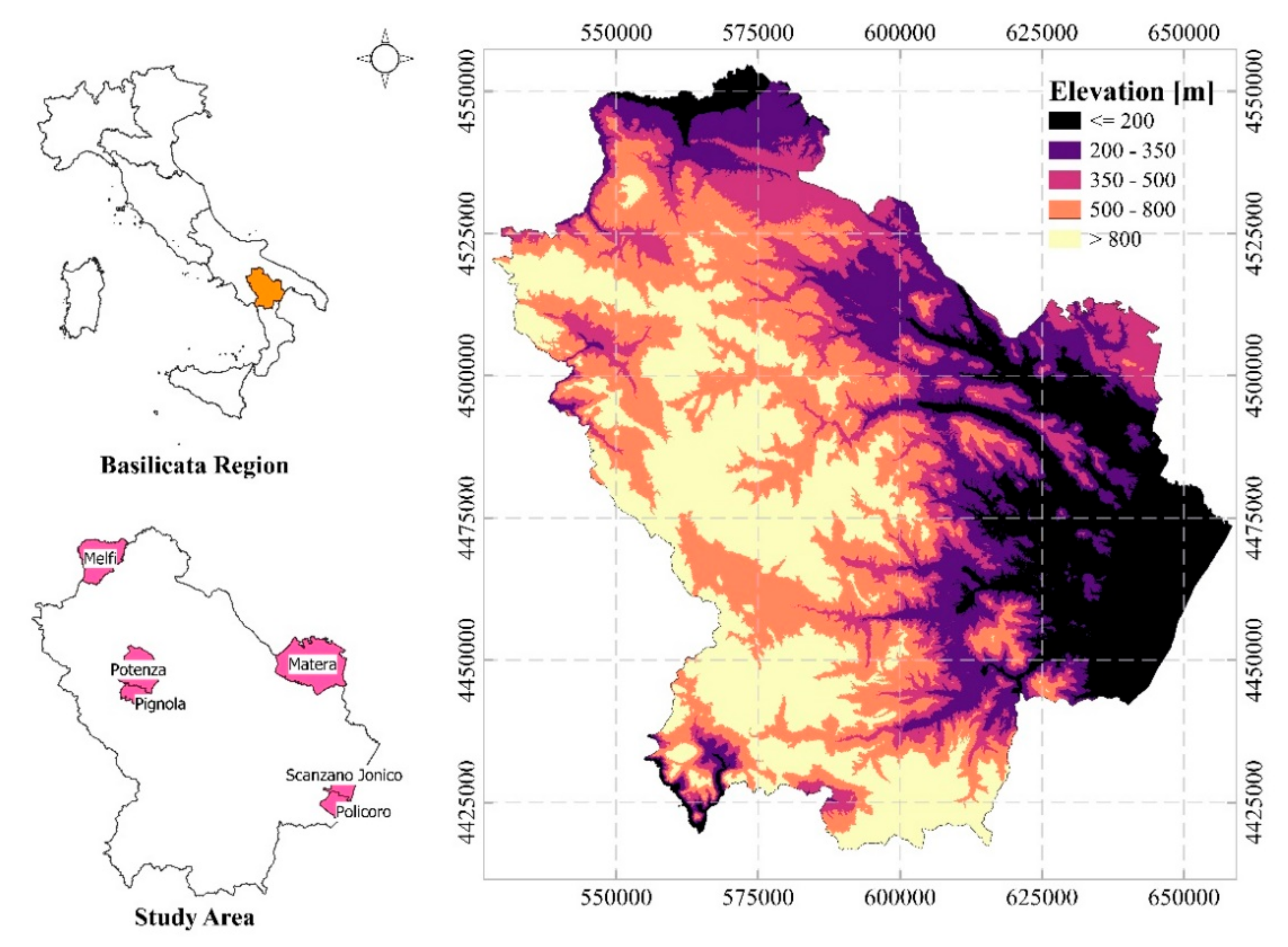

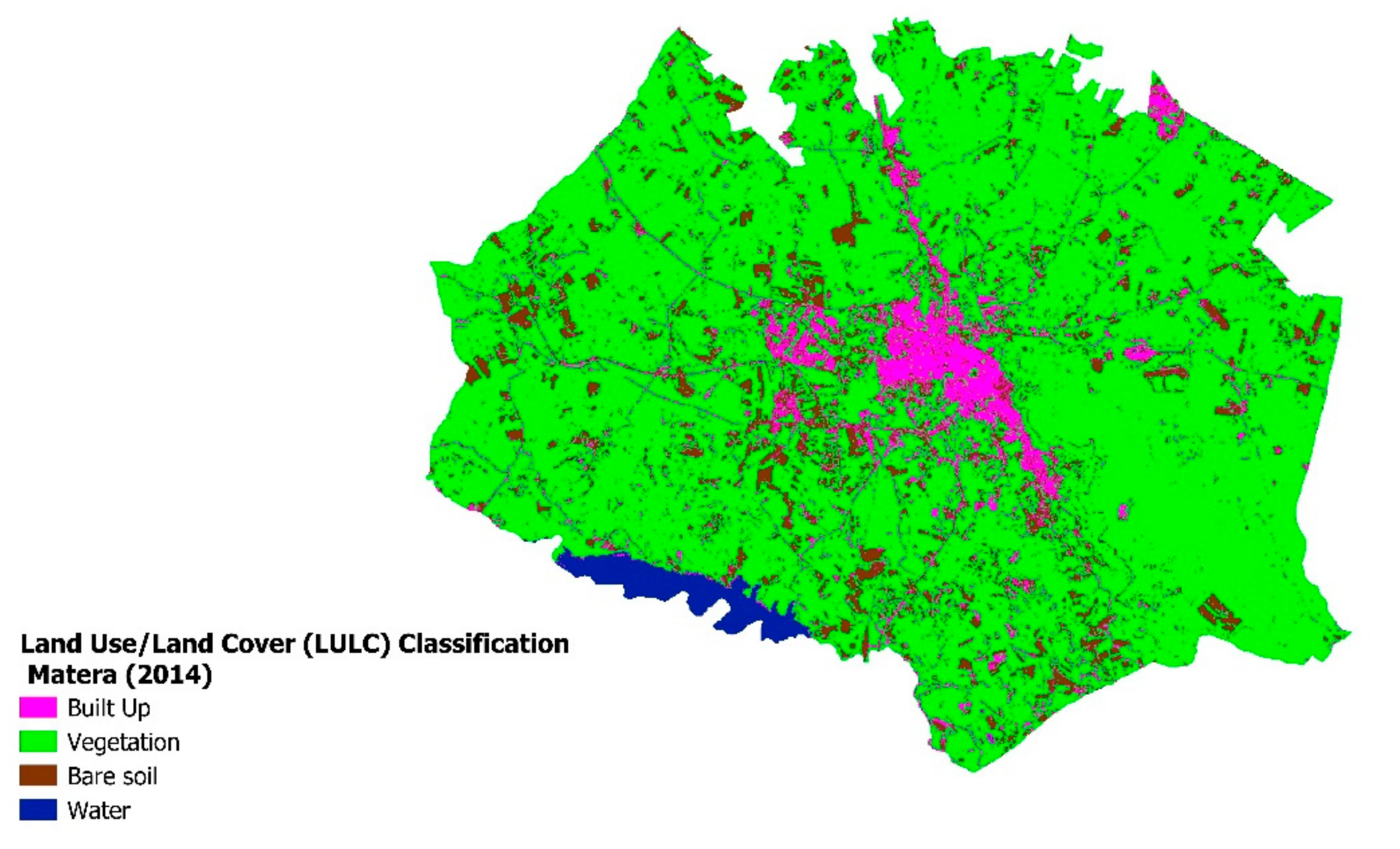
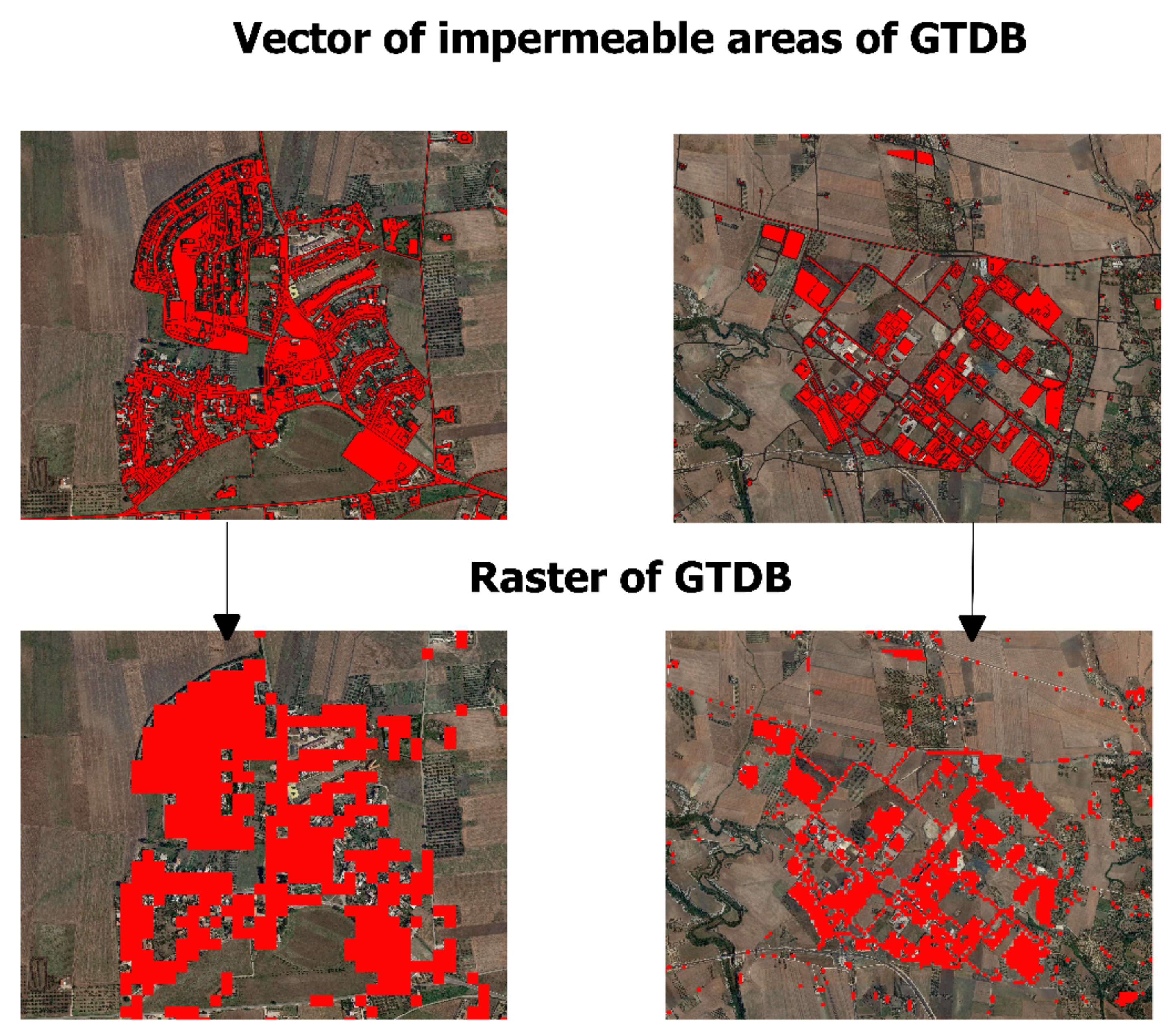

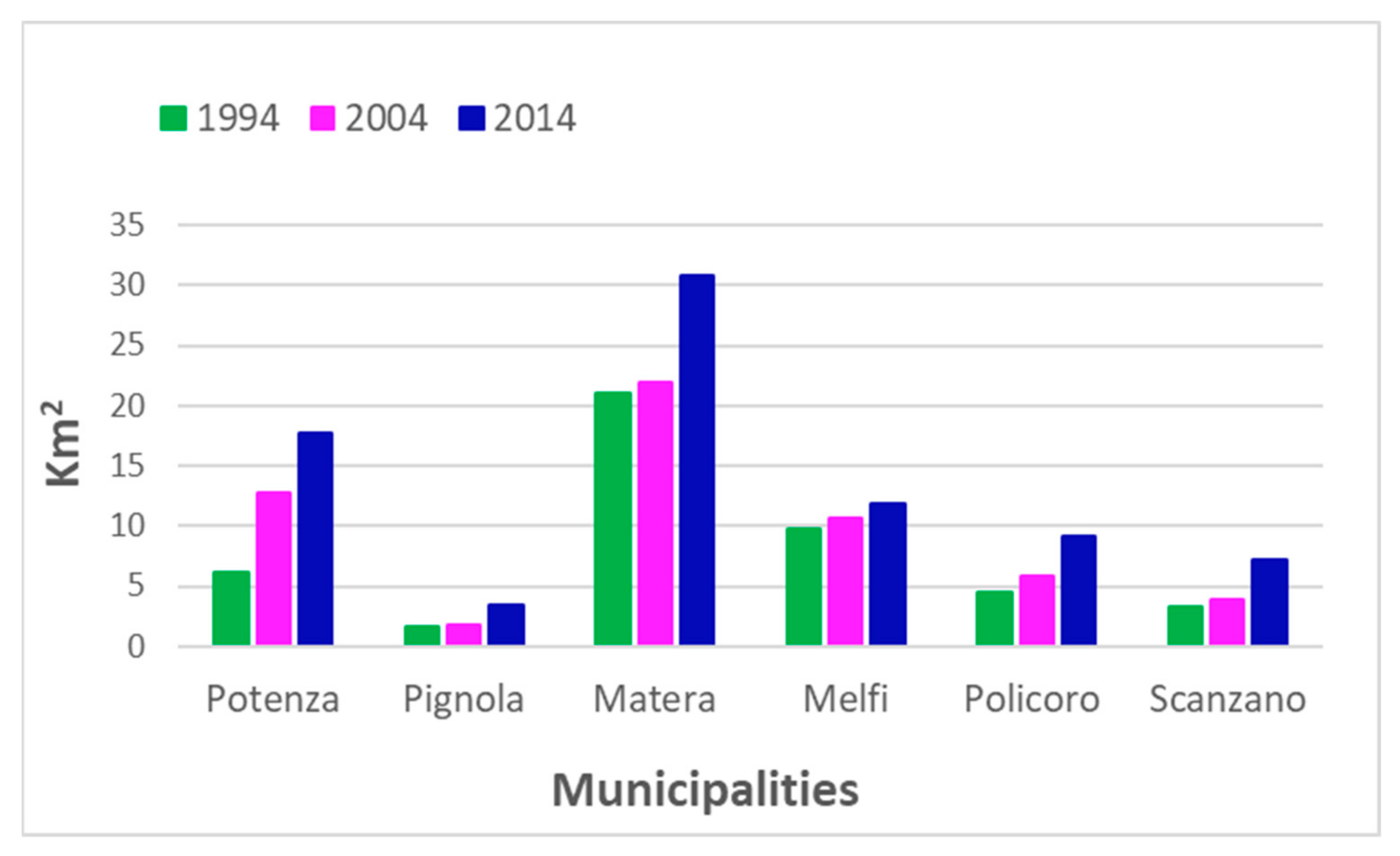

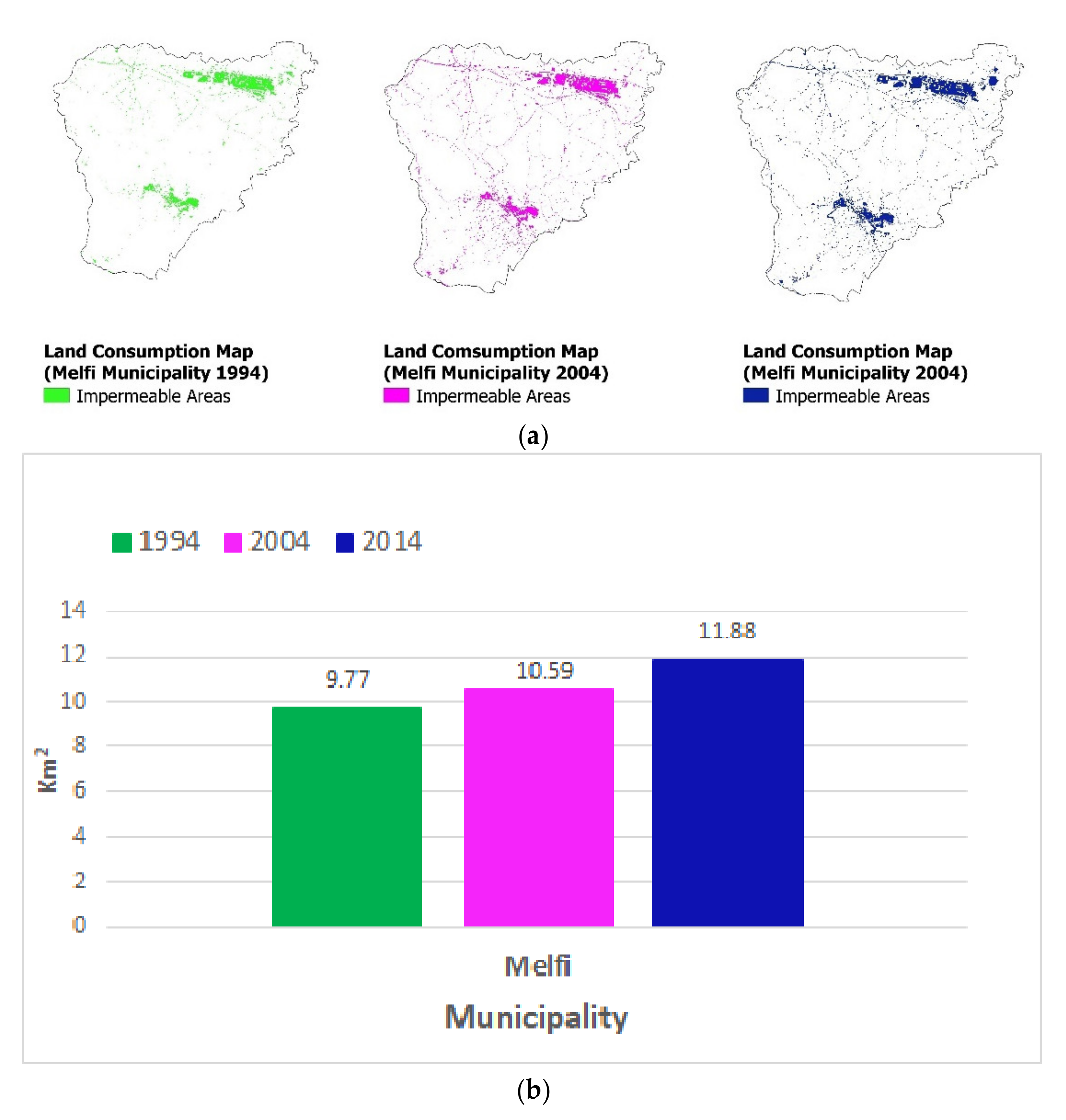
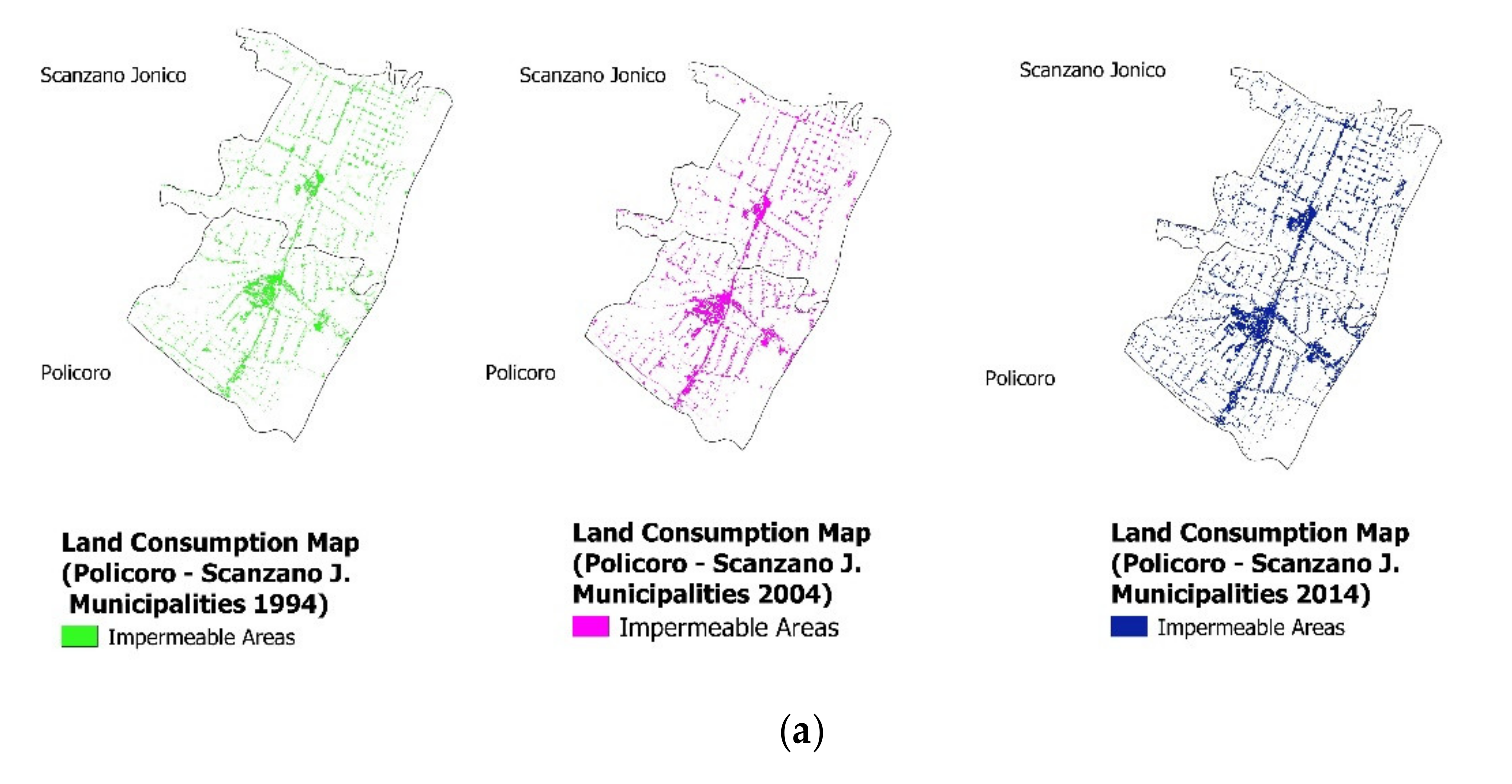
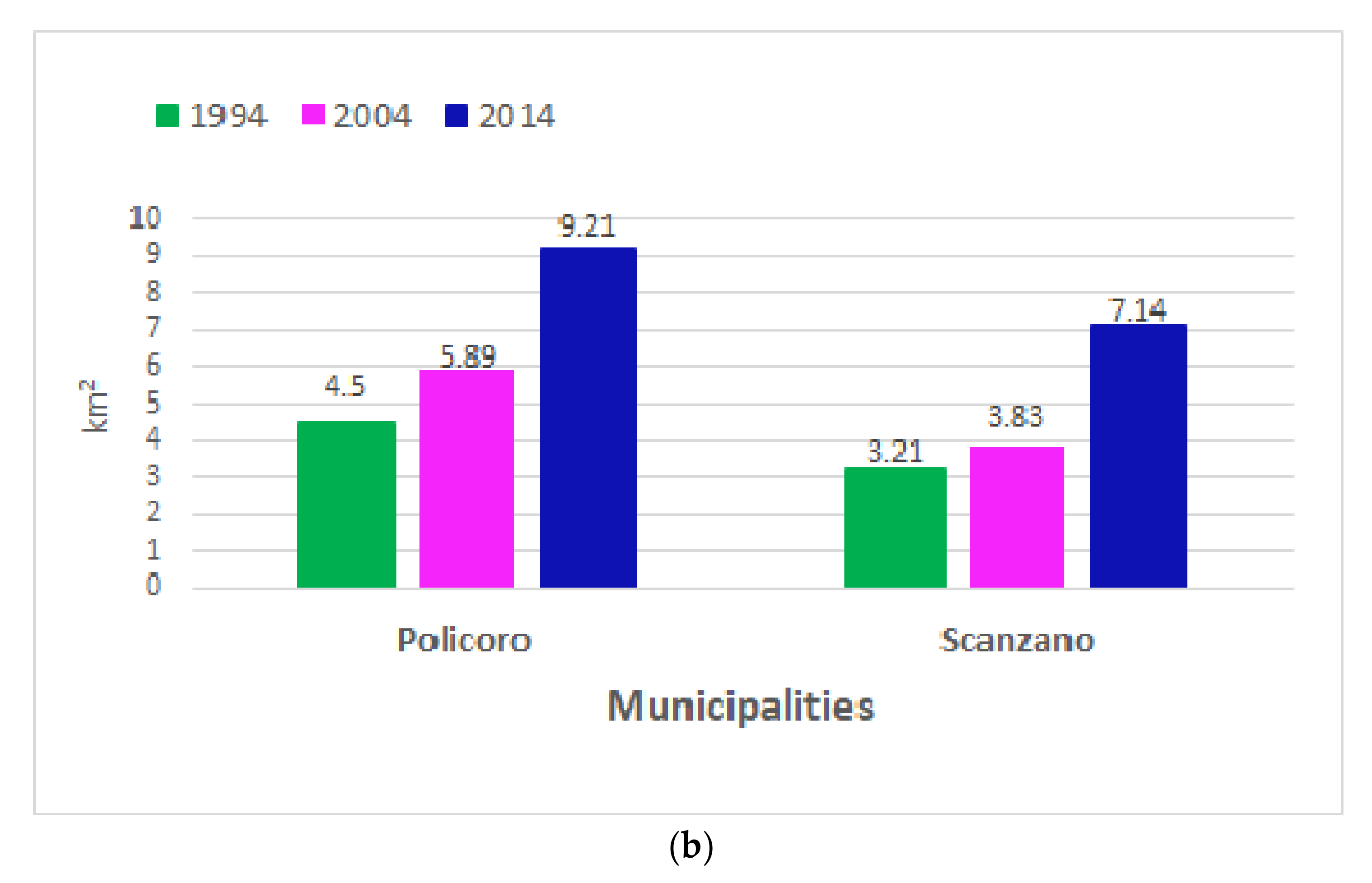
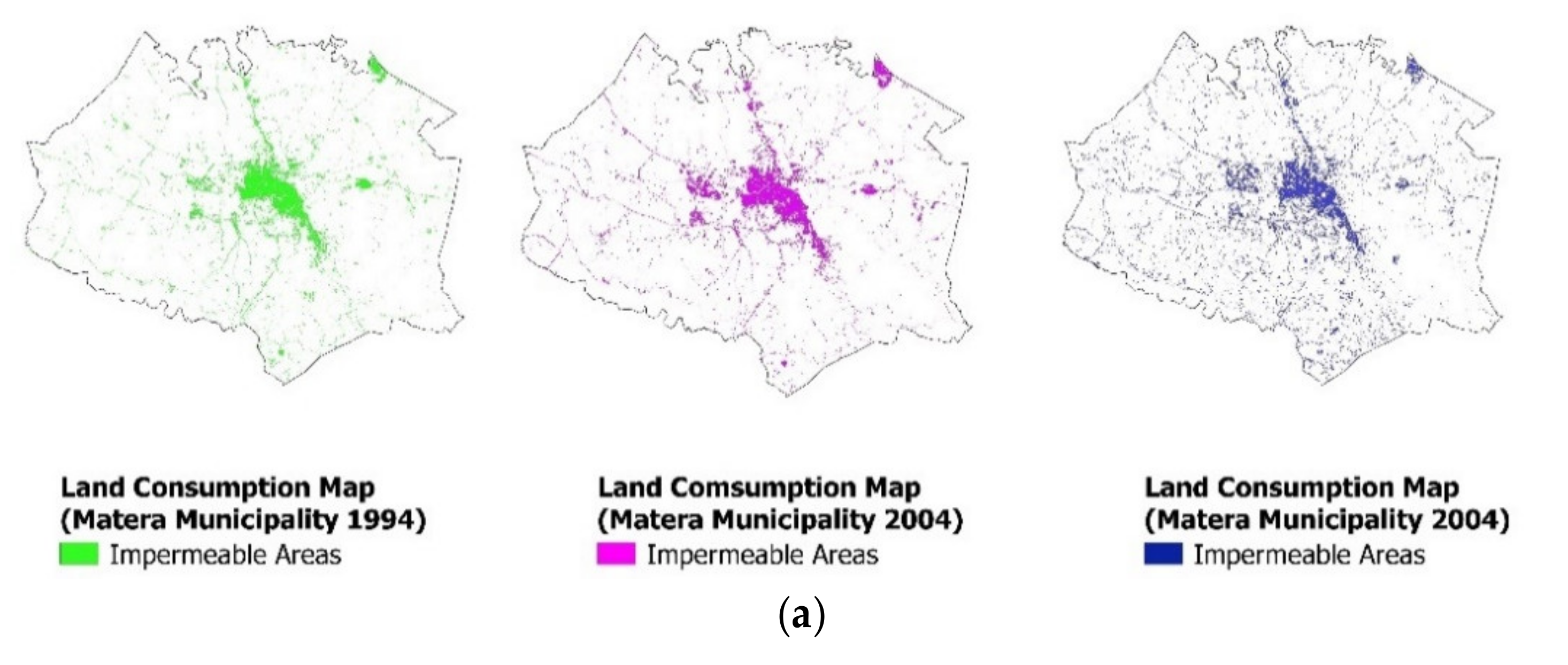


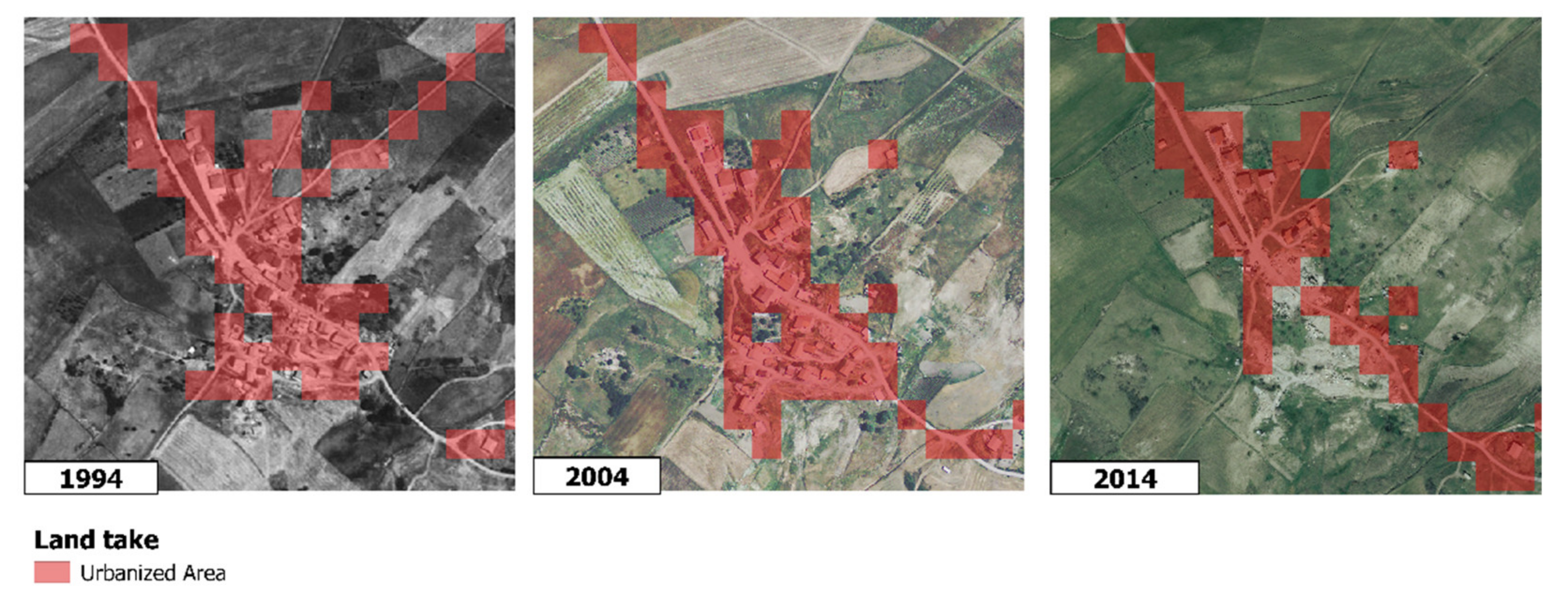
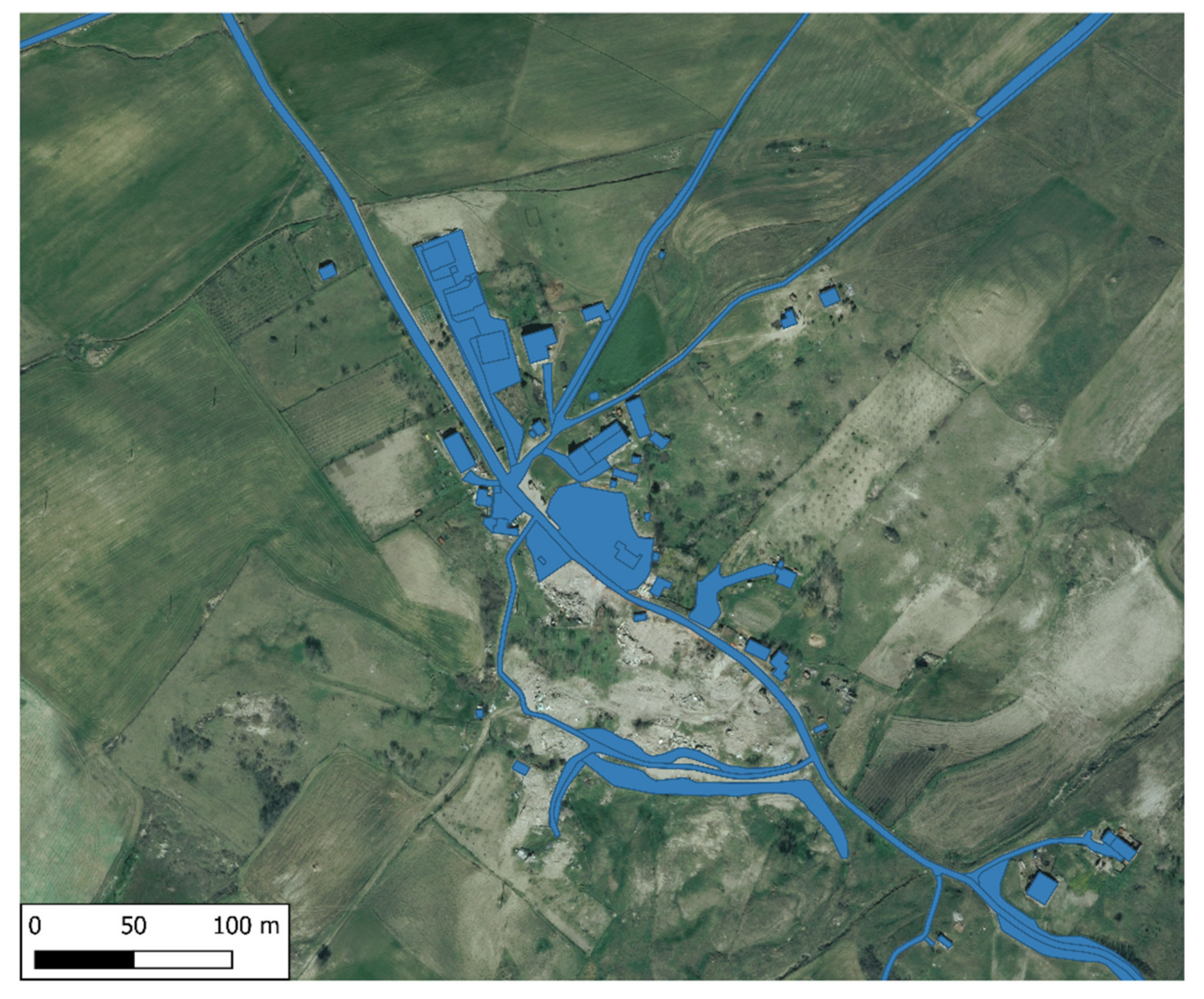
| Landsat 4–5 TM | Landsat 8 OLI |
|---|---|
| Band1—Blue (0.45–0.52 µm) | Band2—Blue (0.450–0.51 µm) |
| Band2—Green (0.50–0.60 µm) | Band3—Green (0.53–0.59 µm) |
| Band3—Red (0.63–0.69 µm) | Band4—Red (0.64–0.67 µm) |
| Band4—Near Infrared (NIR) (0.76–0.90 µm) | Band5—Near Infrared (NIR) (0.85–0.88 µm) |
| Band5—Shortwave Infrared (SWIR) (1.55–1.75 µm) | Band6—Shortwave Infrared (SWIR) (1.57–1.65 µm) |
| Band6—Mid-Infrared (MIR) (2.08–2.35 µm) | Band10—Thermal Infrared (TIR) (10.6–11.19 µm) |
| MC_ID | Definition | Description |
|---|---|---|
| 1 | Urban | Built-up, Streets, Industrial Buildings |
| 2 | Vegetation | Forest, Cultivated Areas, Grassland |
| 3 | Bare Soil | Rocks |
| 4 | Water | Lake, River |
| Overall Accuracy (%) | Kappa Hat Coefficient | Classes | User Accuracy (%) | Producer Accuracy (%) |
|---|---|---|---|---|
| 94.28% | 0.9281 | Class 1 (Built-up) | 89.213 | 92.989 |
| Class2 (Vegetation) | 94.237 | 95.660 | ||
| Class 3 (Bare Soil) | 93.434 | 91.735 | ||
| Class 4 (Water) | 100 | 99.759 |
Publisher’s Note: MDPI stays neutral with regard to jurisdictional claims in published maps and institutional affiliations. |
© 2022 by the authors. Licensee MDPI, Basel, Switzerland. This article is an open access article distributed under the terms and conditions of the Creative Commons Attribution (CC BY) license (https://creativecommons.org/licenses/by/4.0/).
Share and Cite
Santarsiero, V.; Nolè, G.; Lanorte, A.; Tucci, B.; Cillis, G.; Murgante, B. Remote Sensing and Spatial Analysis for Land-Take Assessment in Basilicata Region (Southern Italy). Remote Sens. 2022, 14, 1692. https://doi.org/10.3390/rs14071692
Santarsiero V, Nolè G, Lanorte A, Tucci B, Cillis G, Murgante B. Remote Sensing and Spatial Analysis for Land-Take Assessment in Basilicata Region (Southern Italy). Remote Sensing. 2022; 14(7):1692. https://doi.org/10.3390/rs14071692
Chicago/Turabian StyleSantarsiero, Valentina, Gabriele Nolè, Antonio Lanorte, Biagio Tucci, Giuseppe Cillis, and Beniamino Murgante. 2022. "Remote Sensing and Spatial Analysis for Land-Take Assessment in Basilicata Region (Southern Italy)" Remote Sensing 14, no. 7: 1692. https://doi.org/10.3390/rs14071692
APA StyleSantarsiero, V., Nolè, G., Lanorte, A., Tucci, B., Cillis, G., & Murgante, B. (2022). Remote Sensing and Spatial Analysis for Land-Take Assessment in Basilicata Region (Southern Italy). Remote Sensing, 14(7), 1692. https://doi.org/10.3390/rs14071692









